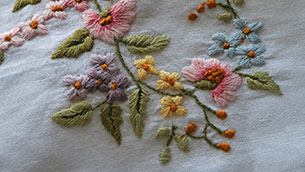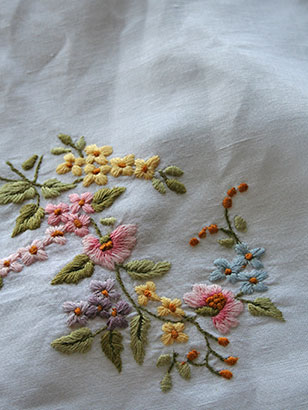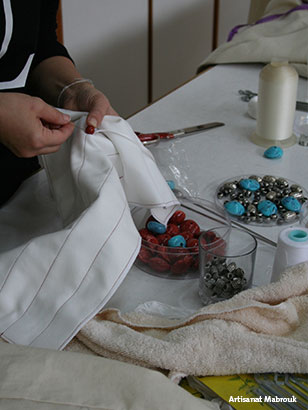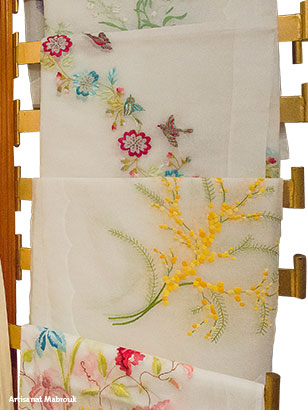The heritage of embroidery is an important part of Lebanon’s cultural tapestry but it’s a tradition in fast decline. We meet the women of Artisanat du Chouf and Artisanat Mabrouk who are among the associations preserving its place in the future.
The tradition of embroidery in Lebanon stretches back generations, from the hand embroidery of mountainous villages all over Lebanon to the work of nuns in isolated convents. It’s a female inheritance passed from generation to generation that, despite its long history, is at risk of dying out, as a throwaway culture of cheap machine-made imports dominate the market and few of today’s younger generation learn the time-consuming art from their family.

Luckily a handful of associations are working to keep the tradition alive, with some focusing on handmade embroidery work and others using intricate machine work. With Lebanon becoming the home for displaced communities in the region, the country’s rich tapestry of cultures can be seen in its diverse embroidery. INAASH, the Association for the Development of Palestinian Camps has worked on preserving the heritage of Palestinian embroidery and providing work for refugee families in Lebanon since the 1960s and NGOs such as Basmeh wa Zeitooneh help Syrian refugee women to make an income through embroidery. In the same way that these NGOs are giving women both financial independence and stability, many of Lebanon’s oldest embroidery associations started for the same reason.
Set in a beautiful traditional stone heritage house in the village of Baakline is Artisanat du Chouf, which aims to preserve the Lebanese heritage of hand-embroidery and to provide work for local women. Inside is a treasure trove of embroidery pieces from a row of traditional abayas with intricate hand-stitched patterns that must have taken years of work, to a kitsch hand-stitched “Thank you for not smoking” sign along with towels, napkins, scarves and tablecloths all featuring the delicate handiwork in varying stitches.
A group of seven local women, the core workers of the artisan, are gathered inside, with a bigger network of women working on embroidery from their homes. Many of these women, taught by their mothers and grandmothers, have worked on embroidery since they were kids and a few were young girls when they joined the artisan, founded in 1959 by Jamal Alameddine Takieddine, who recently celebrated her hundredth birthday. “Jamal’s idea was to create work for women to make an income from their own homes,” says her daughter-in-law and now the artisan’s director, May Takieddine. “It was the first call for the economic independence of women. At her time it was a very big step.” She pulls out and unfolds a large wall hanging in purples, lilacs and greys with exceptional detail. “In the 1970s Lebanon, Jamal had ladies working all the way from the mountains to the south. Her work was booming, but now people are reluctant to pay in these difficult times. This kind of embroidery is a luxury,” says Takieddine. “Before you would take an embroidered tablecloth for life and care for it. Now the trend is to buy something cheap and only use it once. Machine work from China is replacing it.”
After years of working together the women of Artisanat du Chouf have become like family – their gatherings are like social meetings with women crocheting and stitching while making jokes. Nouha Amer is the artist of the center and sketches or paints out the designs before the other women gather and agree on the best selections and colors. “I’ve worked here for 34 years. I haven’t been to a school to study it but I really love this work,” Amer says. Each woman has her own specialty which includes traditional embroidery techniques from makkuk – made from one thread with an old bone instrument – to needlework and crochet and various types of embroidery from shadow stitch, a pattern worked from behind the material, to Richelieu, where holes are cut out between stitches. “Ladies who were pushing this barely exist anymore,” says Siham Khodor, an entrepreneur passionate about Baakline’s rich cultural history and supporter of the artisan. “We are pushing young girls to keep this kind of work. It’s our heritage.”
“It was the first call for the economic independence of women”
In a large brightly-lit basement in the backstreets of Bourj Hammoud a roomful of women work at separate workstations with the whir of sewing machines fusing with the laughter of children playing above in a school playground. Artisanat Mabrouk, a not-for-profit initiative of St. Vincent de Paul, was founded by Member of Parliament Gilberte Zouein Abou-Hamad in 1986 and is run by a core team of women including Aline Fattal, Maude Khayyat, Alice Tamer, Marie Claude Bittar and Brigitte Khairallah. “We started during the civil war. The idea was to have women working at home all year round, to allow them to stay by their children rather than in a factory,” says Fattal. “We decided embroidery and sewing was something they already knew how to do and it perpetrates the tradition.” The workshop though is not only about keeping a tradition of Lebanese embroidery alive, it’s also a social project to give fairly paid work to families in need.
The artisan started in Fanar with women coming together one morning a week with their work, which started with knitting. “It was a disaster,” Fattal jokes. “We had no idea how to make things at the beginning.” Since then the artisan has built up a solid reputation for their work, which sells in a Downtown Beirut boutique, along with customized orders.
Inside it’s a hive of activity; two women fold a huge tablecloth in front of a rainbow wall of colored threads, a cloud of steam temporarily hides two women pressing designs onto material. A couple of women work on machine-work embroidery, and another sews the final sequins and beads on a delicate jacket. Behind each woman’s workstation is a board with colorful embroidered designs of flowers, fruits, red-roofed Lebanese houses and animals, pinned for inspiration. From a rail hang some of the final pieces from delicate jackets rich in embroidery that take a minimum of five days to put together to white lace baptism dresses.
“It’s refined work,” says Tamer while proudly displaying tablecloths with Arabic and Phoenician lettering. “They’re arriving at a degree of perfection. It looks like work by hand but it’s all done by machine. Look at those flowers,” she says pointing to the work on a black silk jacket. “They’re beautiful.”
With these organizations keeping the rich heritage of embroidery alive and reviving it for modern times, they are also continuing a strong female tradition, which offers stability and independence to modern day women.
Artisanat du Chouf
- Mon-Thu 9am-1.30pm and appointments
- Tel: +961 5 305 937 / +961 3 376 644
- Facebook page: Artisanat du Chouf – مشغل الشوف
Baakline
Artisanat Mabrouk
- Tel: +961 1 989 200
- Instagram: MABROUK ARTISANAT (@yasmina_mabrouk)
Downtown
EMBROIDERY AROUND THE COUNTRY
There are numerous women and associations keeping the art of embroidery alive around Lebanon from Douma to Zouk Mikhael, from North to South. Here are just a few of them:
-
The workshop of Mona Doumit
It includes a network of more than 20 women who work from home. Over the last 40 years she’s built a solid reputation for her tablecloths and cushion covers. She customizes special designs to order for individuals and for designers.
Tel: +961 3 652 483
-
The handicraft of May Joumblat’s workshop
It is a fine example of embroidery work from the Chouf region. Once situated in Saifi Village, the delicate work is now available by order.
Tel: +961 3 334 401
-
Leyli Saad
She has dedicated her life to keeping embroidery alive and to offer work to women. The workshop produces diverse embroidery pieces highlighting each of the woman’s specialties. She is renowned for her embroidered organdy tablecloth. Currently Saad works on demand.
Tel: +961 4 712 448
-
INAASH
Since it was founded in the 1960s INAASH almost 10,000 Palestinian women have been trained in preserving the heritage of Palestinian embroidery and almost three million pieces of handiwork have been made.
Tel: +961 1 740 609
Website: inaash.org
Location: Bikhazi and Charif Bldg, Sidani Street, Ras Beirut
-
The association Basmeh wa Zeitooneh (basmehzeitooneh)
It helps the embroidery work of Syrian refugee women to reach customers and for them to gain their own financial independence.
Tel: +961 76 939 238
Website : basmeh-zeitooneh.org
Email: contact@basmeh-zeitooneh.org
Article edited on October 27, 2021
Loading



